AWOL
Wally
The
Most Famous Doughboy You Never Heard About
Who’s Wally? you ask. And well you might. Almost nobody knows, anymore, who Wally is. Or was. Being a sometime student of the arcane history of cartooning, I knew that Wally was the pen name of a cartoonist named Wallgren and that Wallgren was to World War I what Bill Mauldin was to World War II: a soldier cartoonist whose irreverent depictions of life in uniform relieved the tedium and the tensions of warfare. Or if Wally wasn’t WWI’s Mauldin, he was WWI’s George Baker.
Mauldin created the memorably scruffy, bristle-chinned, stoop-shouldered pair, Willie and Joe, ordinary foot soldiers in wrinkled and torn uniforms who were the taciturn but eloquent witnesses on behalf of the persecuted. Through simple combat-weary inertia, they defied pointless army regulations and rituals: they would fight the war, but they wouldn’t keep their shoes polished. Baker concocted an equally eloquent representative of the down-trodden enlisted man in the Sad Sack, a silent sufferer who in pantomime endured the indignities and injustices perpetually visited upon the low man on the military totem pole everywhere.
Wally did for the doughboys of World War I what Mauldin and Baker did for the dogfaces of World War II. But Wally’s name doesn’t appear in any of the standard histories of cartooning. Not in Stephen Becker’s Comic Art in America. Not in Jerry Robinson’s The Comics. Not in Coulton Waugh’s Comics. Not in Ron Goulart’s Encyclopedia or in any of Maurice Horn’s numerous compendia on the subject.
Thomas Craven, an art critic who in 1944 produced Cartoon Cavalcade, the earliest attempt at a comprehensive overview of the art form, prints two of Wally’s cartoons but doesn’t mention him in his text. And that’s odd because Craven goes on at some length about Bruce Bairnsfather, a Scot in the British army who drew cartoons about World War I and became famous world-wide for it. But Craven doesn’t mention Wally, and Wally was an American soldier who drew cartoons about the same war—cartoons that were exceedingly popular with his fellow countrymen in khaki.
And that was virtually all I knew about Wallgren until curiosity prodded me into tracking down this cartoonist that the history books have overlooked. The nagging question, the ever-present prod, was: Why? Why was Wally doomed to obscurity? If he was so popular then, why is he so unknown now? What became of Wally anyhow?
Some of his history was reasonably easy to discover (albeit not in tomes of cartoon history). Some of it I found in Squads Write! A Selection of the Best Things in Prose, Verse, and Cartoon from The Stars and Stripes (Harper, 1931), edited by John T. Winterich, a Stars and Stripes staff member and, subsequently, author of several books about books and book collecting. Later, a few minuscule but essential details surfaced haphazardly in chanced upon articles in Time (October 17, 1938) and Editor & Publisher (September 11, 1937). And in a newsletter of the National Cartoonists Society.
In
Winterich, we find that cartoons signed “Wally” appeared
on page seven in every weekly issue of The
Stars and Stripes, the serviceman’s
newspaper, beginning
with the first issue on February 8, 1918, and ending with the last
issue, seventy-one weeks later, dated June 13, 1919. And we find that
Wallgren had a first name and an initial—Abian A. The initial,
we learned later yet in Time, stood for Anders. 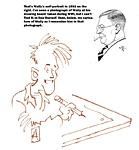
About Wally’s work, Winterich said: “His wholly human, wholly soldier types moved up and down the army, a ludicrous and dowdy battalion, suffering the identical discomforts and predicaments that the rest of us suffered and lending us the God-given and Wallgren-transmitted ability to laugh at our own ordeal by mud and homesickness.”
Cartoonist C. D. Russell was in the Marines during World War I, and he remembers Wally. Russell, who drew a comic strip called Pete the Tramp (which started in the 1932 and continued until 1963), met Wally when they were both in boot camp at Parris Island, South Carolina, in 1917.
“There were great cartoonists in the American Expeditionary Force,” Russell wrote years later in the NCS newsletter, “many of them scattered about on various division papers, but there was only one Wally. ... Wally’s contribution as a prop to the morale of the AEF is inestimable. When The Stars and Stripes came out each week, the hungry doughboys pounced on it avidly, and invariably the first thing they turned to was Wally’s cartoon.”
Wally’s contribution was important enough to attract the attention and support of General “Black Jack” Pershing, who, Russell reports, made a special trip to the paper’s offices in Rue St. Anne in Paris just to meet Wally. Pershing was ushered into the corner where Wally sat at his drawing board, and when Wally arose with perfect military decorum, Pershing commenced: “Private Wallgren, my felicitations to you. Your name is a by-word in the AEF. I have followed the remarkable job you have been doing for this paper, assiduously, and your name is well known to me as it is to every doughboy.”
“Thanks,” said Wally, shifting uneasily from one foot to the other; then, after a pause, he continued, “And your name isn’t entirely unfamiliar to me, Gen.”
There are, Russell assures us, dozens of tales about Wally.
One day, Russell continues, Winterich came upon the cartoonist with his head down on the drawing board, sobbing gently, the current issue of The Stars and Stripes spread out before him.
“What’s the matter?’ asked Wint. “Hangover?”
“No,” sniffed Wally. “Look at this sheet—the biggest circulation of any paper in the world, and me drawing cartoons for it for a buck private’s pay.”
Then his face suddenly lit up, and he said, “Gee, I forgot: I better pipe down. I get $3 a month extra for sharpshooter, and I haven’t fired a shot since I was on the rifle range back in the States. I hope that doesn’t leak back to General Headquarters!”
For eighteen months, Wally bombarded the troops with comedic commentary. Given the precarious circumstances in which his readers found themselves, they were surely more keenly appreciative of the cartoonist’s witty contrivances in their heightened state of self-consciousness than they might have been back home. Back home, they wouldn’t have been threatened hourly with cannon fire and wouldn’t, most likely, be quite as thankful for the things that could take their minds off their discomforts. A cartoon by Wally, for instance.
So Wally, during the adventure of the American Expeditionary Force (AEF) in Europe 1918-1919, was a figure of some renown. And anyone who lived through those muddy months remembered Wally fondly. But Wally the cartooning doughboy was—seemingly, if we are to judge from the formal historical record of cartooning in that neighborhood of the century—thoroughly forgotten sometime between World War I and his death in 1948. And that, as I’ve said, seems odd.
The cartooning soldier celebrities of World War II became civilian celebrities after the war. Bill Mauldin put his weary dogfaces, Willie and Joe, into mufti in a syndicated series called Back Home. After that foundered, Mauldin transformed himself into an editorial cartoonist whose trenchant wit became as notable on the editorial pages of the St. Louis Post-Dispatch as it had been on the pages of The Stars and Stripes.
And George Baker brought his Sad Sack home, too, and draped civilian garb on his punching bag protagonist in order to reveal the bitter albeit humorous reverses to which ordinary life is often prone. Others made famous by their cartooning endeavors while in uniform did the same. Dave Breger continued his wartime feature, Private Breger, as Mister Breger; and Dick Wingert did the same with Hubert.
And their names are in all the history books—or, at least, in some of them. But Wally’s name is nearly nowhere.
World
War I’s other cartooning soldier, Bairnsfather, took his
characters—Ol’ Bill, Alf, and Bert—to the stage and
into the movies. There were several books, too—collections of
cartoons and short stories and even a novel. But Wally—well,
there was a collection of his cartoons produced just after the
Armistice, and another in 1933. But neither of these achieved the
circulation that Bairnsfather’s numerous productions did.
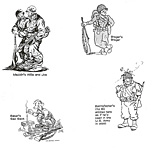
So in comparison to Bairnsfather and Mauldin and Baker and Breger and Wingert, Wally could be said to have virtually disappeared.
And this is all the more remarkable because of the company he kept in the Paris offices of The Stars and Stripes. Most of Wally’s compatriots on the paper were destined to be luminaries of journalism—Alexander Woollcott, drama critic for the New York Times; Franklin Pierce Adams (“FPA”), famed paragrapher for the Herald-Tribune; sports writer Grantland Rice (whose arrival at the Paris office was heralded by the immediate cancellation of the paper’s sports page); Tip Bliss, a poet whose dog attacked Pershing on his visit to the office; Mark Watson, later Sunday editor of the Baltimore Sun; Adolph Shelby Ochs, general manager of the Chattanooga Times; and Harold Ross, gap-toothed, bristled-haired rough-hewn hobo newspaperman, who returned to New York after the War, played poker regularly with his erstwhile comrades-in-arms, and, with their pledges of support, founded The New Yorker magazine in 1925.
Where was Wally in all this? Wasn’t he to be a child of a kindred Destiny? If not, why not? It seemed strange that men who had worked so closely together in Paris to produce The Stars and Stripes for over a year wouldn’t want to keep the famed cartoonist somehow in their journalistic orbit. Today, we call the making and maintenance of these sorts of connections “networking.” And networking worked even before we had a name for it. Ross kept Woollcott and FPA at his elbow through the early years of The New Yorker; and all three were regulars at the Algonquin Roundtable of the twenties and thirties.
If they all got famous (or stayed famous) in the years after the War, why didn’t Wally?
Maybe he didn’t want fame. Maybe he just went back to his home town and to the art department of one of the newspapers there and contributed occasional cartoons to magazines in New York. Even before Wally’s seeming obscurity piqued my interest, I’d seen a paltry few of his cartoons in the 1920s pages of the old humor magazine Life and in The American Legion Magazine in the thirties and forties. But otherwise, as I’ve said, he seems to have slipped off the national map.
That, at least, is what I thought. Peculiar as it seemed, I surmised, none of his Paris comrades sought to perpetuate or capitalize upon his notoriety in the years after the War. And then I realized that one of them did. But before I reveal the benefactor and the nature of the benefaction, let’s look at Wally’s wartime record and his pre-war career. Neither of these phases of his life were particularly prolific in yielding biographical data, but for the sake of historical comprehensiveness, we can scarcely overlook them.
Born in 1892 (or 1891, sources disagree), Wally grew up in Philadelphia, where, at the age of fifteen, he launched his newspaper career as an office boy at the Philadelphia North American, which also operated a syndicate that distributed features nationally. Wally apprenticed under such distinguished cartooners as Herbert Johnson, Walter Bradford and Walt McDougal. After a couple years, Wally was drawing two Sunday comic pages—Inbad the Sailor and Ruff and Ready ( c. 1910-1914). Subsequently, according to Winterich’s account, he “shuttled back and forth” doing sports cartoons at virtually every newspaper in town. And that is about all we know of his pre-war exploits.
When the American Expeditionary Force was mustered to fight the Boche, Wally joined the Marines, who, immediately cognizant of his artistic talents, made him a sign painter, in which capacity he decorated the sides of trucks and the doors of latrines. But he did not last long at this duty. Two days after the Fifth U.S. Marines landed in France on July 2, 1917, Wally was arrested for trying to smuggle two bottles of cognac into camp. As Time reported: “It was the first vagary of a mildly undisciplined disposition which ultimately got Private Wallgren seven court-martials, never for anything more serious than ‘butting an officer in the stomach to get into quarters.’”
Writing an introduction to the 1933 collection of Wally’s wartime cartoons (The AEF in Cartoon by Wally; Dan Sowers, Philadelphia), Alexander Woollcott elaborates on Wally’s earliest weeks in uniform: “Wally had been eight months in France and, when I first saw him, had just been exhumed from the chill gray ooze of Gondrecourt. In strong contrast to his new fellow-workers [at The Stars and Stripes], he was a superb physical specimen, and he was a crack marksman. He had not yet had a shot at the Germans, but he had met and defeated the Marines. Of course his minor infractions of their code had never quite justified his being shot at dawn. They had tried locking him up and confiscating his pay for months ahead. But he had merely used this enforced leisure in drawing picture postcards of the Fifth Regiment personnel, selling the portraits of the enlisted men for five francs each, and those of the officers for ten francs, a class distinction directly traceable to his deep inveterate dislike of officers. By this means, he had maintained, though impoverished by court martial, an income larger than that enjoyed even by his general.”
Sometime during the late fall of 1917, a second lieutenant named Guy T. Viskniskki persuaded various of the Army brass to approve the publication of a weekly serviceman’s newspaper. The brass put Viskniskki in charge, and he revived a name that had first surfaced on a similar publication during the Civil War. Other names were apparently considered briefly—Liberty, Independence—but Viskniskki and his crew settled on The Stars and Stripes, one of them reported, “because it was long enough to go over the full seven columns of the front page.” Looking around for a staff, Viskniskki, who had heard about Wally, asked that he be transferred to the newspaper.
The story is continued, in luxuriously colorful prose, by Winterich: “The selection of Private Wallgren as cartoonist for The Stars and Stripes doubtless caused sighs of relief (assuming a Marine ever sighs) among his betters and unquestionably released whole platoons of officers from juridical duties for active service in the field. Endowed with such worldly goods as Marine supply sergeants customarily issue to their clientele, including a rifle, Private Wallgren entrained for Paris. Invariably of sanguine temperament, he soon determined that the necessity for all this armament in a civilized community like Paris was virtually negligible, and accordingly abandoned it bit by bit all the way into the capital, disembarking with only the clothes he had on. ... How he made his way to The Stars and Stripes office has never been disclosed, but it was, perhaps, a fortunate coincidence that the office of The Stars and Stripes and the local military hoosegow were under the same roof. To transfer a cartoonist from the other to the one would have been, and perhaps was, the work of a moment.”
Wally thereupon disappeared into the arrondissements of the City of Lights, surfacing briefly at various intervals to produce his weekly quarter-page cartoon for the early Thursday morning deadline. Which he did, apparently, under duress. Woollcott takes up the thread:
“One man was detailed each week to keep an eye on Wallgren, and by the end of the week, this bodyguard would be ready to drop from exhaustion. The experiment of arresting him and flinging him into the brig availed nothing, for the Marines were then policing Paris, and Wally was so adored by them all that they made his cell a charming little den. Whatever he called for was delivered to him as if he were stopping at the University Club. They formed bucket brigades to bring him refreshments. And brought him a beautiful woman each evening on a platter.”
The all-hands staff effort to get the illusive not-to-say refractory Wally to meet his weekly deadline was amply rewarded. His prodigious talent for procrastination was matched by an unerring instinct for cartooning that contributed hugely to what Woollcott calls “the persistent tone of disrespect” for all things miliary that infected the paper. According to Time: “Wally’s doughboys ... were pathetic but unfrightened little runts wallowing in mud, beset by cooties and all the creature discomforts of trench warfare. Most endearing to his readers and most distressing to some General Staff ‘brass hats’ was Wally’s wholehearted disrespect for M.P.s, top ‘sargints,” second ‘looies,’ and all forms of military discipline. Toward the more sanguinary aspects of the War, Wally maintained an attitude of good-humored fatalism.”
To which Woollcott added: “When Bairnsfather started drawing his famous Old Bill sketches for the London weeklies, some bird-brain in the House of Commons got up and demanded that he be disciplined for insulting the heroes of the nation with his grotesque drawings. But that protest was drowned in a roar of scorn from the heroes of the nation themselves. By the same token, there were certain stuffed shirts at the AEF General Headquarters who felt that if only Wallgren could be thrown off The Stars and Stripes, that newspaper might hope to be as dignified as The Army and Navy Journal. But against the overwhelming enthusiasm of the AEF itself, those stuffed shirts never had a chance. The Wallgren drawings were allowed to go their own ruffianly way.”
For inspiration, Wally often looked no further than the newspaper’s office. He created no regular cast of characters—no Willie, no Joe; no Hubert or Private Breger. (And that fact may in some way account for his low national visibility in the postwar years.) But a reappearing albeit unnamed personage in his cartoons was a caricature of Private Hudson Hawley, the most prolific writer on the staff (who had almost single-handedly produced the first couple issues of the paper). Ross also appeared every once in a while. And so did Woollcott, who elaborates on Wally’s penchant for subjecting his fellow staffers to pictorial scorn and derision:
“The incurably military Hawley was always shown as saluting with the vehemence of a cartherine-wheel if a Polish Second Lieutenant chanced to pass by a block away. I was always pictured as stout and timorous, and the likeness—though unkind—was so striking that passing truckloads of soldiers, seeing me on the road, would shout at me and ask me how I had escaped from the cartoon. It was Wallgren’s delight to show me swooning with fear because a tire had just blown out in my vicinity.
“He
always used to draft his strip in pencil,” Woollcott continues,
“and then at the last minute ink the final version. Whenever I
was in Paris, he would invariably sketch me as one complying with all
the regulations—overseas cap, wrap leggings, service stripes,
and so forth, but to my deep confusion, carrying a single lovely
rose. This libel he would show me just before the inking process
would rivet it for posterity. There would be a silent exchange of
glances between us. ‘Get your hat,’ I would say, and off
we would retire to the nearest bar, where the blackmailer would smack
his lips over cognac for which I paid. The strip would then be
published without the rose.”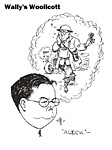
In March 1919, a 96-page collection of Wally’s cartoons were published by The Stars and Stripes. Entitled Wally: His Cartoons of the AEF, the elongated 7x18-inch paperback reproduced the cartoons from the newspaper’s plates. The booklet sold for five francs with the profits ear-marked for 3,444 French war orphans. Unhappily, military regulations seemed likely to frustrate this noble scheme: the Judge Advocate, getting wind of the plan, ruled that the money could not be given to orphans but must be turned over to the U.S. Treasury. Nevertheless, there’s some indication that the wiley Ross managed to subvert the red tape long enough to get some of the proceeds directed to the deserving French waifs.
In
the jottings of Winterich and Woollcott, we have the most copious of
the written record on Wally. Wally during the War. What happened to
Wally after the War is only hinted at here and there in fragmentary
notations in other fugitive publications. On the back cover of a 1929
booklet of barrack room songs that Wally decorated (“my most
artistic effort” he called it), I read a brief description of
his military career that included mention of his cartooning for a
publication called Home Sector. 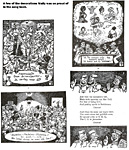 And that
rang a Harold Ross bell and sent me to Genius
in Disguise, Thomas Kunkel’s masterful
1995 biography of The New Yorker’s founder. Here was the missing link between The
Stars and Stripes and The
American Legion Magazine, between Wally’s
military and civilian careers. Wally
did not, actually, descend into obscurity after the War. Rather, he
maintained a national visibility, but it was almost exclusively with
his Stars and Stripes readers.
And that
rang a Harold Ross bell and sent me to Genius
in Disguise, Thomas Kunkel’s masterful
1995 biography of The New Yorker’s founder. Here was the missing link between The
Stars and Stripes and The
American Legion Magazine, between Wally’s
military and civilian careers. Wally
did not, actually, descend into obscurity after the War. Rather, he
maintained a national visibility, but it was almost exclusively with
his Stars and Stripes readers.
As the AEF sojourn in Europe came to a close, Ross was invited by Butterick Publishing Company to edit a weekly magazine to be called Home Sector, which was designed to be an imitation Stars and Stripes, aimed deliberately at the presumably vast readership of returning WWI vets. Since Ross enjoyed so much his stint on The Stars and Stripes (where he had been the chief honcho since the Armistice, November 11, 1918), he leapt at the chance to continue in a similar capacity and with the same loyal audience.
The Stars and Stripes staff was discharged effective April 30, 1919, and Ross arrived in New York and started working on Home Sector in early June 1919. To implement the plan of producing an imitation The Stars and Stripes, Ross recruited several of his old crew: he made Winterich his managing editor, and he asked Woollcott and Hawley to help, and LeRoy Baldridge, the staff artist. And he enlisted Wallgren to do cartoons. The magazine started appearing weekly that summer with 40-48 pages, but its regular publication was interrupted by a printers’ strike in New York that fall. Flailing about for 23 issues, it lasted only until the end of March 1920.
As Home Sector began to look shaky, the publishers seized an opportunity to have it “absorbed” by The American Legion Weekly, a magazine that aimed at the same audience as Home Sector had. The American Legion Weekly had started July 4, 1919, shortly after the American Legion itself was formed (in May 1919). With the consolidation, Ross was asked to assume the editorship, which he did, staying for four years, until March 1924 when he left to take co-command of the faltering humor magazine, Judge. But that didn’t last: Ross bailed out of the sinking ship after five months (that is, in August 1924) to begin working in earnest on his prospectus for The New Yorker (which would begin publication the next February). Meanwhile, Winterich inherited the editorial reins at the American Legion Weekly. And he also inherited Wally, who had come along as part of the editorial furniture of Home Sector.
And that’s what Wally did after the War.
For better than twenty years thereafter, Wally was the more-or-less official cartoonist of The American Legion Magazine (as it was called after it ceased weekly publication in 1926 and began coming out once a month). Although Wallgren had returned to newspaper cartooning in Philadelphia after the War, he submitted cartoons for the Legion by mail, and they appeared regularly in its pages. He did humorous spot illustrations for various of the magazine’s articles, and he usually did a full-page comic strip. He also resurrected his Hudson Hawley character, creating “the salutin’ demon,” a mousy soldier who instinctively salutes everything that walks whether outranked or not. The character’s popularity grew over the years, and by the mid-1930s, some state Legion conventions held contests for “salutin’ demon” impersonators, offering handsome prizes to the winners.
In 1933, Wally did a few cartoons for Happy Days, a national weekly in the mold of Stars and Stripes, established by Melvin Ryder, one-time staff member of the WWI paper, to serve the needs and interests of the Civilian Conservation Corps. Another S&S alum, artist C. Leroy Baldridge, also contributed briefly, but the paper was a success in the pseudo-military CCC camps around the country and soon attracted cartoon submissions from others, so Wally and Baldridge withdrew.
Later, Wally produced two short-lived comic strips. Debuting October 18, 1937, The Muddleups was about married life, but the material was clearly not Wallgren’s forte: distributed by Dan Sowers Syndicate, the strip could not have lasted more than a few months. The next October, Wally tried again, this time with a more congenial subject: Hoosegow Herman was about a soldier in the peacetime Army, and for it, Wally drew again upon his WWI experience, drafting both Hawley and Woollcott as characters in the strip. But Herman, despite McNaught distribution, didn’t last more than a year, if that.
Wally’s post-war national fame, whatever his status in Philadelphia’s environs, was confined pretty much, it appears, to the membership of the American Legion, who read in their magazine regular reminders of their AEF antics in Wally’s comic spots and strips.
There’s something just a little musty about Wally’s American Legion work. His drawing style retains the fustian feel of pre-1920s cartooning, and his frequent references to raucous AEF escapades give his humor a nostalgic locker room flavor, making his comedy almost wholly reliant on fond reminiscence.
Nothing strange about that. For Wally, as for many Americans of his generation, the AEF experience was the most memorable of their lives. And Wally was able to indulge this memory as a regular assignment for the rest of his life.
Harold Ross, meanwhile, founded The New Yorker. But he couldn’t take Wally with him there. Sadly, Wally’s folksy graphic mannerisms would have been glaringly out-of-place in Ross’s sophisticated weekly. But at least Ross hadn’t entirely neglected the famed AEF cartoonist in those post-War years: he had drafted him for Home Sector.
While this recitation outlines what became of Wally in those post-war years, it doesn’t answer the biggest question. Why didn’t Wally become as famous a cartoonist as Mauldin did or Baker or Breger? The most well-known of the Second World War G.I. cartoonists parlayed their military celebrity into civilian success on a scale much grander than Wally’s niche in the American Legion. Their cartoons were nationally distributed by newspaper feature syndicates. Willie and Joe and the Sad Sack and Mister Breger were household words. Why didn’t Wally launch a newspaper comic strip immediately after the War, capitalizing on his fame to reach a fortune?
Well, as it turns out, it wasn’t for lack of opportunity.
Upon Wally’s return to the U.S. in 1919 after the War, every feature syndicate in the country was his doormat. They were all after him, according to C.D. Russell. Russell reminisces about Wally in a spring 1948 issue of the newsletter of the National Cartoonists Society. In Philadelphia’s Upper Darby, Wallgren had just died (on March 24 or 25, sources vary) of a liver ailment (brought on, doubtless, by Wally’s consuming interest in adult beverages), and Russell was recounting the doughboy cartoonist’s achievements.
Generally speaking, the propositions made to Wally by the syndicates were all the same: draw anything you want and write your own ticket.
Herbert Bayard Swope, the fabled editor of the New York Morning World, was apparently the most agile of those in pursuit of Wally: he corralled the cartoonist for lunch in midtown New York one day. Russell reconstructs the luncheon conversation, and I do the same here, taking my cue from Russell.
When Swope got around to the only business he had in mind, he proposed that Wally do a daily and Sunday comic strip for his paper and syndicate at a hitherto unheard of guaranteed salary. But Wally didn’t seem happy about it.
With a long face, he looked at Swope and said, “You mean six strips a week and a full page on Sunday, Mr. Swope?”
“That’s it,” replied Swope.
“Well, Mr. Swope, you’re a pretty nice fella,” Wally said morosely, “but at the end of my first week doing this, I’d be six days behind on the daily and one week behind on the Sunday, and at the end of six weeks, I’d be six weeks behind on the dailies and on the Sundays, and then you’d start writing and phoning and wiring me, asking me where the strips were, and I’d get to the point where I’d hate you. And when my work didn’t come in, you’d get to the point where you’d hate me.”
Wallgren heaved a huge sigh and then continued.
“You like me, don’t you, Mr. Swope?” he said. “After all, you bought the lunch.”
“I like you fine,” said Swope. “I think you have a great future, and I like you very much.”
“Well, I like you, too,” Wally said. “Let’s leave it that way. Right now, I like you, and you like me. I’m going on thirty, and at my age, I can’t afford to make enemies. Let’s stay friends. No comic strip, and no deadlines.”
And with that, the inimitable Wally declined Swope’s offer—and all others—to catapult his wartime celebrity into syndicated comic strip fame and fortune. Instead, he just went back to Drexel Hill, a suburb of Philadelphia, where he drew for his hometown papers and for American Legion, where he was able to relive his carefree AEF days in cartoons whose nostalgic appeal guaranteed him a devoted readership among the other veterans of that European adventure in the century’s second decade, and where the deadlines didn’t come so often as to make him any enemies.
And that’s who Wally was, and why we don’t hear much about him anymore.
Now here’s a gallery of Wally—or a Wallery, if you like—arranged more-or-less in chronological order, beginning with an example of his pre-WWI style and going through the Stars and Stripes years, then a couple 1920s pages for the old humor magazine Life, the American Legion material (including the storied Salutin’ Demon) and concluding with samples of his two comic strips.
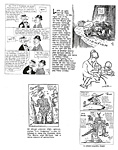 |
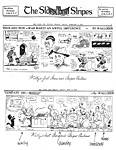 |
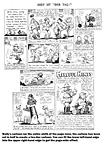 |
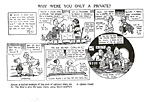 |
 |
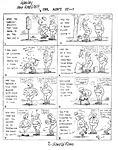 |
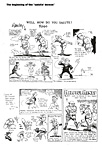 |
 |
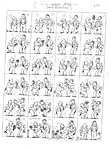 |
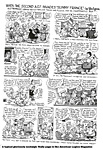 |
 |
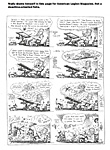 |
 |
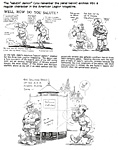 |
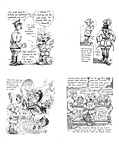 |
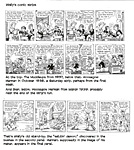 |
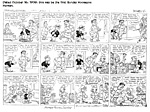 |
